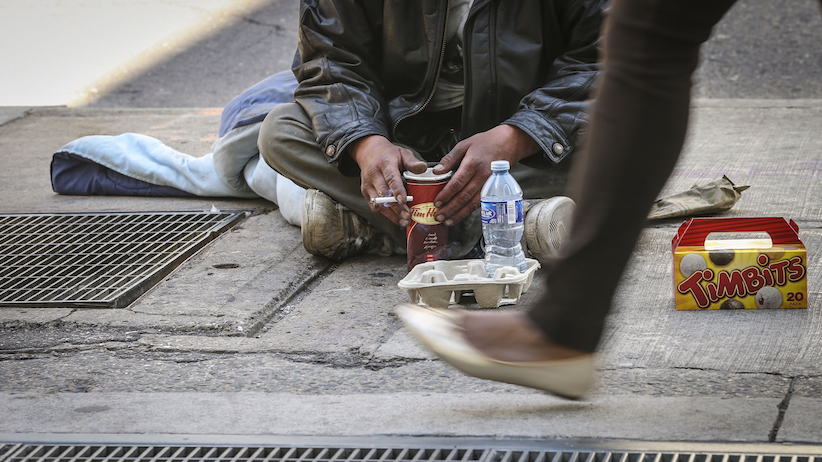There’s a better way to fight homelessness than emergency shelters
OPINION: Housing First initiatives are better at combatting homelessness than shelters, and make more fiscal sense for taxpayers, too
TORONTO ON – Michael Manitowabie 42, panhandles on his corner at Richmond and Simcoe as he has done (according to him) for 20 years June 18, 2013.
Share

Recently, the Salvation Army of Canada announced its intention to build a 350-bed facility a literal stone’s throw away from my family home in Ottawa. Given the lack of public consultations that preceded the announcement, it came as a significant shock to both my family and the rest of the neighbourhood.
After the initial shock of the announcement wore off, many of us began researching what this facility would mean for our community. It would be comprised of 140 emergency-shelter beds plus an additional 210 beds for various types of residential treatment. A facility of this magnitude would not only have the typical impacts associated with condo developments, such as added traffic, noise, etc., but would also bring many more people struggling with addictions into the neighbourhood. And as the Salvation Army does not engage in harm reduction programs, such as needle exchanges or supervised injection, drug use, drug dealing, and alcohol consumption in public spaces can be expected to increase.
I initially felt as though commenting on this facility was not in my wheelhouse. My background is in economic and fiscal modelling and forecasting. And, although I have worked on evaluating public policy more than the average Canadian, evaluating models of effective service delivery for the homeless is not an area in which I have any expertise.
However, the more I researched this issue, the more I realized how central funding to support homelessness and addiction is to social policy at every level. And, as such, it has a significant impact on the fiscal frameworks of federal, provincial, and municipal governments.
At the federal level, the previous-Conservative government committed “nearly $600 million over five years (2014-2019) starting in April 2014 to renew and refocus the Homelessness Partnering Strategy (HPS) using a Housing First approach.” Then, the current-Liberal government committed an additional $112 million over two years in Budget 2016 to Housing First initiatives, and a further $2.1 billion over 11 years in Budget 2017.
Housing First, as defined by the federal government, involves “moving primarily individuals who are chronically or episodically homeless from the streets or homeless shelters directly into permanent housing. Permanent housing is complemented by the provision of services to assist clients to sustain their housing and work towards recovery and reintegration into the community.”
The reason for this multi-partisan support for Housing First is due to the results of the federal-government sponsored research project, At Home/Chez Soi. The largest project of its kind in the world, it established pilots in five Canadian cities (Vancouver, Winnipeg, Toronto, Montreal and Moncton) in 2009 to examine outcomes of the Housing First approach. The At Home/Chez Soi Final Report “demonstrated that a Housing First approach can be effectively implemented in Canadian cities both large and small, to rapidly reduce homelessness while alleviating pressure on shelters and health and judicial services. Once stable housing is obtained, the focus shifts to more enduring issues, such as addiction and mental health.” Indeed, in the last six months of the study, “62 per cent of Housing First (HF) participants were housed all of the time … whereas 31 per cent of treatment as usual (TAU) participants were housed all the time …” Further, “Among participants who were housed, housing quality was usually better and more consistent in HF residences than TAU residences.” So, we know from this work that “Housing First rapidly ends homelessness.”
But, while it’s clear that Housing First is much more effective than the emergency-shelter model in combatting homelessness, what is the fiscal impact? Fortunately, this too is a good news story.
According to researchers at McGill, using the data from the At Home/Chez Soi project, “Support services for homeless people with mental illness in Canada’s biggest cities cost more than $55K a year per person on average.” To put that in perspective, the average Canadian earns just shy of $50K annually before taxes.
Meanwhile, researchers in Regina found that Housing First created cost savings of nearly $75,000 per person annually through lower costs of policing, days in hospital, emergency room visits, and detox visits. Further evidence is provided by the MaRS Centre for Impact Investing. In their ‘Housing First Social Impact Bond Feasibility Study’, the authors found that Housing First was consistently cheaper across measures of ‘health and justice use’ as well as ‘overnight stays’ due to lower incidence. Still further research in other jurisdictions, such as Victoria, has confirmed the same thing.
In all, I have been unable to find any evidence that does not support Housing First over emergency shelters, either from a cost or outcome perspective. This begs the question: Why are tax dollars being spent on expensive emergency shelters when we know they are ineffective at combatting homelessness and addiction?
In this case, as in all others, evidence matters, and citizens should demand politicians base their decisions on it. When they do, we are all better off.
Randall Bartlett is the chief economist of the Institute for Fiscal Studies and Democracy
